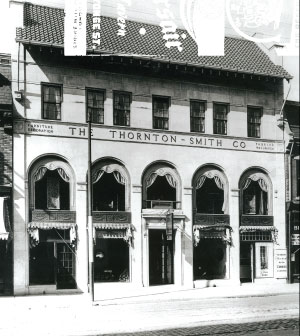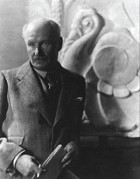Arts And Culture In The Heart of Downtown Yonge Street

The Thornton-Smith Building was designed by Irish-born architect John M. Lyle, a leader in the Toronto architecture profession and champion of the neoclassical Beaux-Arts style. Having grown up in Hamilton, Ontario, Lyle studied architecture at Yale University and at the École des Beaux-Arts in Paris, France. Upon graduation in 1896, he worked for architectural firms Howard & Cauldwell and Carrere & Hastings in New York City In 1905, Lyle returned to Toronto design and build the Royal Alexandra Theatre on King Street. This prominent commission enabled him to establish his own practice, Atelier Lyle.
Lyle helped disseminate Beaux-Arts Classicism through his commissions. While the style peaked in America prior to the First World War, many younger Canadian architects championed the use of Beaux-Arts well into the 1920s – Lyle was considered a leader amongst this faction of professionals. His style grew to incorporate floral and faunal motifs inspired by the Post-Impressionist style of Canadian painters The Group of Seven.
In 1926, the Ontario Association of Architects held an exhibition of members’ post-war works, at which Lyle exhibited drawings for the Thornton-Smith Building along with two other structures. Deemed “the finest work on view at the present convention,” the Lyle won first place in the commercial category and the OAA’s first gold medal award for his work on the Thornton-Smith Building.
The building became a featured portfolio accomplishment for Lyle, who later designed the Commemorative Arch at the Royal Military College in Kingston, Ontario, Union Station in Toronto, Ontario, and the Thomas B. McQuesten High Level Bridge in Hamilton, Ontario.
Thornton-Smith Company
The opening of the Thornton-Smith Company was led by painter and decorator Mabel Cawthra Adamson (1871-1943), member of the prominent Cawthra family of Toronto.  Adamson studied at the Guild of Handicrafts under Charles Robert Ashbee (1863-1942) while living in England from 1902-3, a centre of the British-led Arts and Crafts design movement. Upon her return to Canada in 1903, she co-founded and was elected the first president of the Society of Arts and Crafts in Canada. Later renamed the Canadian Society of Applied Art, the group made a conscious effort to provide the individual names of artisans featured in annual exhibitions in order to foster appreciation of Canadian craftspeople and manufacturers.
Adamson studied at the Guild of Handicrafts under Charles Robert Ashbee (1863-1942) while living in England from 1902-3, a centre of the British-led Arts and Crafts design movement. Upon her return to Canada in 1903, she co-founded and was elected the first president of the Society of Arts and Crafts in Canada. Later renamed the Canadian Society of Applied Art, the group made a conscious effort to provide the individual names of artisans featured in annual exhibitions in order to foster appreciation of Canadian craftspeople and manufacturers.
In 1903, Adamson established the first Canadian branch of the Thornton-Smith Company, to capitalize on the popularity of Arts and Crafts furnishings within Toronto’s consumer market. The Company’s first art director was Scottish-born decorator Peter Charles Browne. The Thornton-Smith Company sold fabrics, drapery, carpets, windows, mosaics, custom-designed furniture, period reproduction furniture, and electric fixtures. Along with providing interior design services for individual clients and architects, and specialized in the decoration of churches and theatres.
Through connections made by Adamson’s husband, Agar Adamson (1865-1929), the Company was hired to furnish the Senate Chamber in Ottawa in 1904. This much-publicized refurbishment was followed by a commission in 1906-7 to decorate the new Royal Alexandra Theatre in Toronto under architect John M. Lyle. Adamson’s family provided key legal and financial support for the growth of the Thornton-Smith Company, with her husband Agar serving as titular head of the firm. In 1921, Mabel Adamson’s brother William Herbert (“Bertie”) Cawthra hired Lyle’s firm, Atelier Lyle, to design and build a new location for the Thornton-Smith Company at 340 Yonge Street.
Prominent tenants
When The Thornton-Smith Company opened in 1922, the northerly entrance of the building was leased to Laura Secord Chocolates. The confectionary company, founded by Frank P. O’Connor in 1913, had opened its first retail location just a few doors north at 350 Yonge Street but relocated to 340 Yonge Street as can be seen in a photo taken in the 20’s.
During the 1950s the Thornton-Smith Building housed Allen Stores Limited, which occupied both 340 and 346 Yonge Street. The department store sold women’s wear and home furnishings, and was considered a discount alternative to Eaton’s.
In 1966, brothers Jack and Ken Rutherford moved their growing photography store, The Toronto Camera Exchange, from Church Street to the new location at 340 Yonge Street. Started by their father George Rutherford in 1946, the company quickly became a major Canadian photographic supplier with stores and a mail-order business which reached photographers across the country. The Toronto Camera Centre at 340 Yonge Street occupied all four floors of the Thornton-Smith Building, and became Canada’s largest photographic store.
Today, Thornton-Smith is a very vibrant building and is occupied on the main floor by Champs Sports, an international retailer and on the second floor by Salad King, a Toronto “landmark” that has been serving Thai food in the neighbourhood for over 20 years. Renovations are currently taking place on the third floor where an exclusive heritage event venue will be opening in January 2015.
Since the mid-1990s, a number of other prominent businesses have occupied The Thornton-Smith Building, including Foot Locker, an international retailer and Reilly’s Restaurant & Bar a well-known pub in the neighbourhood which hosted many successful events over the years including Ryerson Pub Nights.
Heritage recognition
The Thornton-Smith Building is one of the few surviving early 20th-century buildings on the west side of Yonge Street between Dundas Street East and Gould Street. North of Gould, 362A Yonge Street (c.1914) is also identified on the City’s heritage inventory.[29] Most of the remaining building stock which represented the early 20th century development of Yonge Street as the City’s “main street” has been replaced or concealed by large billboard signs.
On March 15, 1974, the Thornton-Smith Building was added to Inventory of Heritage Properties maintained by the former City of Toronto, making it a listed heritage building.